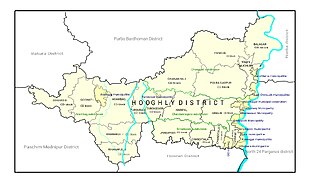Infrastructure
Tarakeswar has 89 villages, all with electricity. Forty-one villages have more than one source of drinking water (a tap, well, tube well, or hand pump); seven villages have only a tube (or bore well), and 36 have only a hand pump. Eight villages have post offices, 14 have sub-post offices and three have post-and-telegraph offices. Sixty-three villages have landlines, 58 have public call offices, and 82 have mobile-phone coverage. Forty-six villages have roads, and 29 have bus service. Eighteen villages have agricultural credit societies, eight have commercial or co-operative banks, and one village has a bank ATM. [15]
Agriculture
The agricultural area has several cold-storage facilities. [16] Although rice is the district's main crop, potatoes, jute, vegetables and fruits are also grown. [17]
Land reform has changed patterns of land ownership. In 2013-14, people engaged in agriculture in Tarakeswar consisted of bargadars (10.17 percent), patta (deed) holders (4.73 percent), small farmers—owning 1–2 hectares (2.5–4.9 acres)—8.24 percent, marginal farmers—less than 1 hectare (2.5 acres)—35.20 percent, and agricultural labourers 41.65 percent. [14] Tarakeswar has markets in Baliguri, Champadanga, Santoshpur and Kararia. [18]
The CD block had 95 fertiliser depots, 38 seed stores and 47 fair-price shops in 2013-14. [14] It produced oil seeds, 81,189 tonnes of Aman paddy (the main winter crop) from 27,792 hectares (68,680 acres), 5,229 tonnes of Boro paddy (a spring crop) from 1,668 hectares (4,120 acres), 58,340 tonnes of jute from 2,730 hectares (6,700 acres), and 81,573 tonnes of potatoes from 5,105 hectares (12,610 acres). [14] The total irrigated area was 11,828 hectares (29,230 acres); of this, 7,125 hectares (17,610 acres) were irrigated by canal water, 1,780 hectares (4,400 acres) by tank water, 50 hectares (120 acres) by river lift irrigation, 480 hectares (1,200 acres) by deep tube wells, and 2,393 hectares (5,910 acres) by shallow tube wells. [14]





